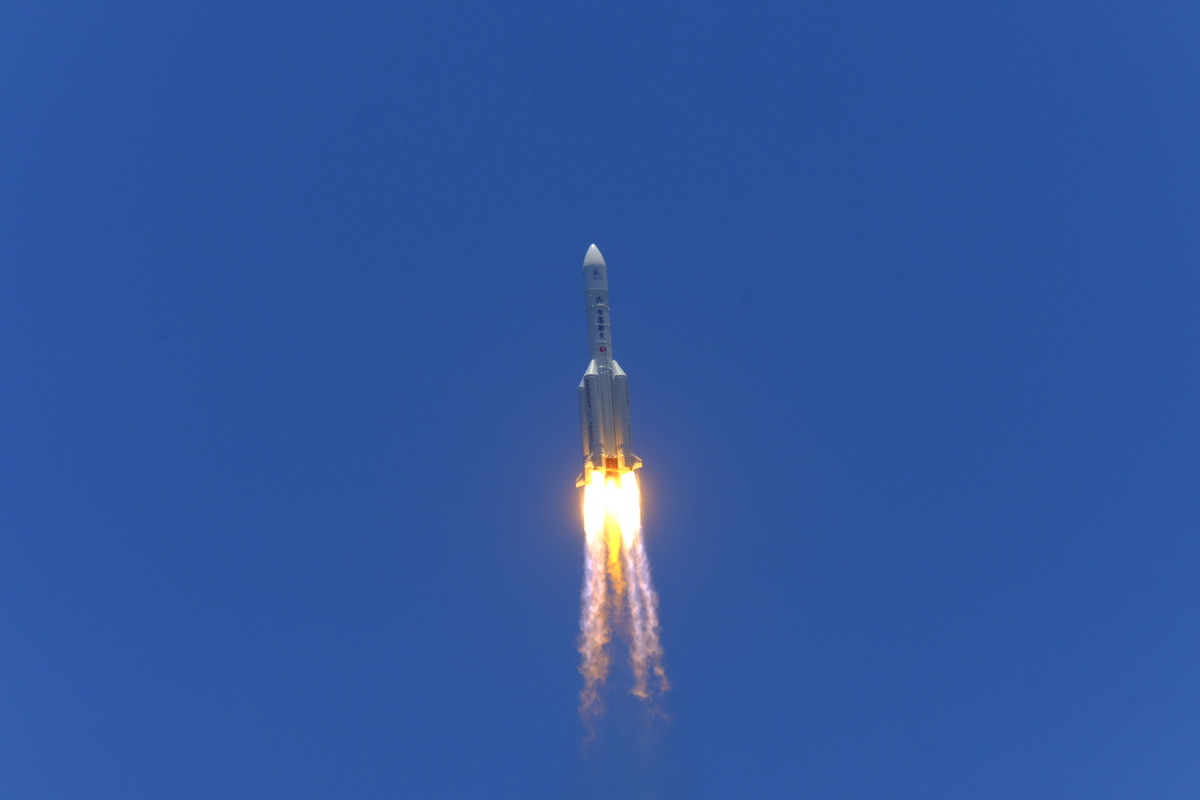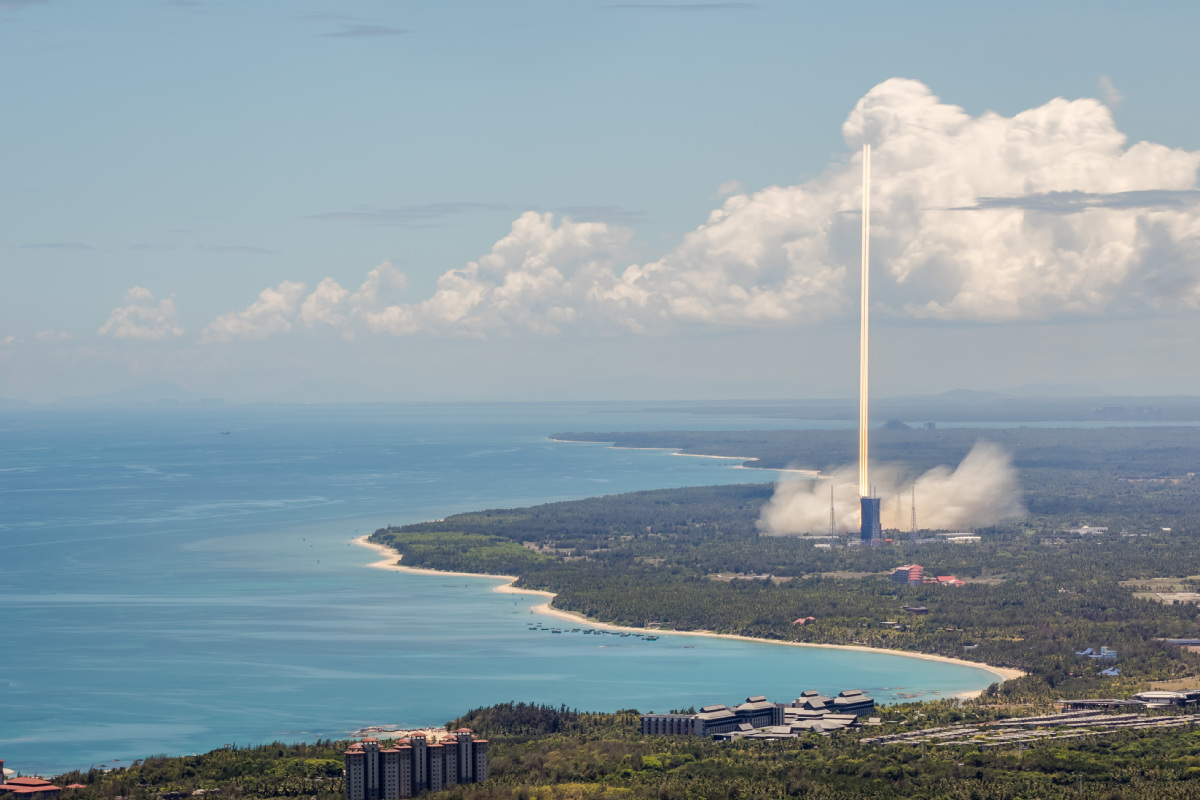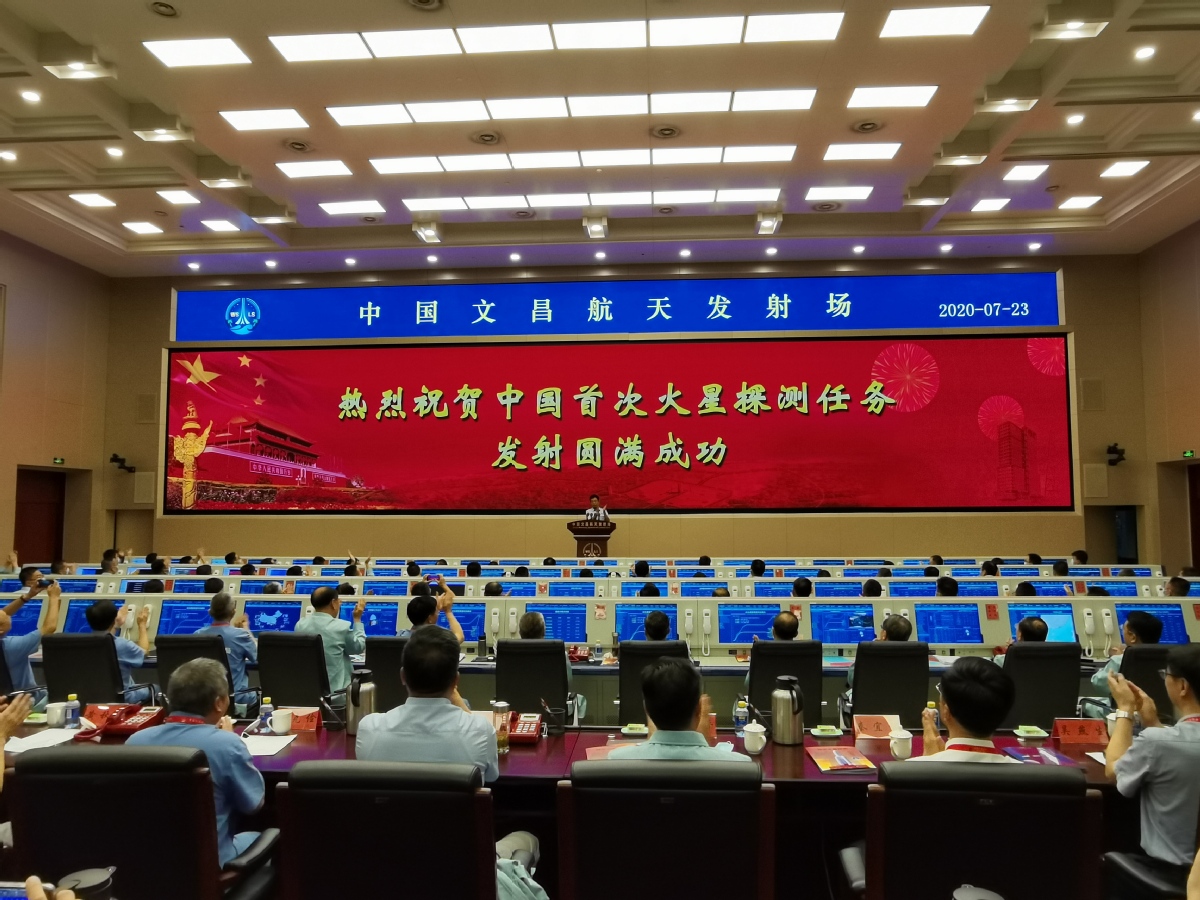China embarks on first independent mission to Mars

Tianwen 1 probe expected to reach red planet in just under seven months
China launched its first independent Mars mission on Thursday from the Wenchang Space Launch Center in Hainan province, marking the start of the nation's planetary exploration program.
As the launch sequence started at 12:41 pm, 10 engines at the bottom of the Long March 5 carrier rocket's first core stage and four boosters roared to life, generating a combined thrust of more than 1,000 metric tons to lift the gigantic vehicle and its payload, the Tianwen 1 robotic probe, into a bright blue sky dotted with white clouds from the coastal launch complex in Wenchang.
The 57-meter rocket, the strongest and most technologically sophisticated in China's launch vehicle family, flew for more than half an hour before placing the spacecraft on an Earth-Mars transfer trajectory. The flight set a speed record for the country's rocket fleet as it surpassed the escape velocity of 11.2 kilometers per second required to get away from Earth's gravitational pull.
If everything goes according to schedule, the 5-metric ton Tianwen 1, which consists of two major parts – an orbiter and a landing capsule – will travel more than 400 million kilometers in nearly seven months before getting captured by the Martian gravitational field, the China National Space Administration said.

Several mid-course and deep-space correction maneuvers will be made during the spaceflight to make sure the probe is precisely aimed at the red planet.
After the probe enters Mars orbit, it will revolve around the planet for two to three months to investigate the landing capsule's preset landing site before descending to release the landing capsule, which will gradually drop through the Martian atmosphere.
During the entry, descent and landing process, the capsule will first use a heat shield to decelerate, which means the craft will rely on aerodynamic drag to slow itself down. It will then deploy a parachute to further reduce the speed and drop its heat shield and later its back shell. In the next step, the capsule will drop the parachute and ignite its retrorockets.
When the craft reaches about 100 meters above the surface, it will suspend the descent and spend some time observing and analyzing the selected landing point to check for obstacles like rocks. With a positive result, the lander will continue descending until the last moment, when the retrorockets will be shut down, allowing it to touch down steadily on Martian soil, according to the administration.

Experts have dubbed the entire landing operation, expected to take about seven minutes, "the riskiest moment" of the Mars mission.
The lander will later unlock the rover to allow it to move onto the Martian surface.
Weighing about 240 kilograms, the rover, which has yet to be named, has six wheels and four solar panels and will be able to move 200 meters per hour on Mars. It carries six scientific instruments, including a multispectral camera, ground-penetrating radar and a meteorological measuring device, and is expected to work on the planet for about three months. If the highly autonomous machine functions well, it will become the fifth rover deployed on Mars, following four from the United States.
Meanwhile, the orbiter will continue circling the red planet for mapping and measurement tasks with seven scientific apparatus, including a high-resolution imager and a magnetometer. It will also relay signals between ground control and the rover.
China's first Mars rover is scheduled to soft-land on a suitable site in the southern part of Mars' Utopia Planitia around May 2021, said Liu Tongjie, spokesman for the Tianwen 1 mission.
Liu Tongjie, deputy head of the space administration's Lunar Exploration and Space Programs Center, said a Mars mission features plenty of uncertainties and risks. China became capable of planning and realizing such a sophisticated mission because the country has gained a great deal of engineering capabilities and know-how through the successful implementation of the Chang'e lunar exploration program.

"We've made many tests and experiments to verify our plans and equipment. We have also prepared a vast ground-based network for deep-space tracking and remote control," Liu said, adding that his engineers had produced a lot of emergency-response plans to handle unexpected scenarios.
If Tianwen 1 can fulfill its three objectives — orbiting Mars for comprehensive observation, landing on the planet and roaming its surface to conduct scientific operations — "it will become the world's first Mars expedition accomplishing all three goals with one probe," said Ye Peijian, a leading deep-space exploration scientist at the China Academy of Space Technology.
Before Tianwen 1, there had been 45 Mars exploration missions since October 1960, when the former Soviet Union launched the world's first Mars-bound spacecraft, but only 17 have been deemed successful.
The most recent attempt before Tianwen 1 was the Emirates Mars Mission, the fourth space program of the United Arab Emirates and the first interplanetary mission by the Arab world. It launched the Hope orbiter on Sunday atop a Japanese rocket from the Tanegashima Space Center in Japan.

Depending on the two planets' orbits, Mars is from 55 million km to 400 million km from Earth.
The most fuel-efficient launch windows for a Martian expedition occur at intervals of approximately 26 months, and that is why previous attempts from different spacefaring parties usually took place at the same time.
There are currently six Mars orbiters in active service and two rovers on operating on the planet's surface.
The history of the Chinese people's observation of Mars can be traced back more than 3,000 years, with ancient astronomers calling the celestial body Yinghuo, or Perplexing Fire, because in their eyes it looked like a capricious, shimmering flame in the night sky.
In August 2010, eight distinguished Chinese scientists suggested to the government that the country should consider the feasibility of deep-space explorations beyond Earth's moon.
In January 2016, the planetary exploration program was approved by the government and tasked to the China National Space Administration.

Major parties involved in the Tianwen 1 mission include China Aerospace Science and Technology Corp, a State-owned space conglomerate that designed and built the rocket and spacecraft; the Chinese Academy of Sciences, which is responsible for the ground-based scientific applications network; and the China Satellite Launch, Tracking and Control System, responsible for launching, controlling and tracking the probe.
The mission also involves international cooperation, with the Chinese space administration collaborating with the European Space Agency and the Argentine space agency for mission tracking and joint efforts on scientific payloads with French and Austrian space researchers.
Meaning quest for heavenly truth in Chinese, Tianwen is a long poem by famous ancient poet Qu Yuan of the Kingdom of Chu during the Warring States Period (475-221 BC). He is known for his patriotism and contributions to classical poetry and verse, especially through the poems of the Chu Ci anthology, also known as Songs of Chu.
Naming the mission after the poem showed China's determination to explore deep space and implant the love of science in young people, the space administration said.
In the second step in China's Mars exploration program, a larger probe will set off for Mars around 2030 to take samples that will be returned to Earth, space officials have said.
China also has a long-term goal of sending people to Mars, the country's manned-space authorities announced last year.
























